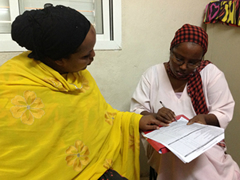- Home
- Technical Cooperation Projects
- Index of Countries
- Africa
- Djibouti
- The Project for Capacity Development of Midwives
- Project News
- Follow-up activities of in-service training (the development and validation of checklists for midwifery operational procedures (validated on March 29th, 2014) and the supervisory visit to health facilities (from April 28th, 2014)
Project News
2014-04-28
Follow-up activities of in-service training (the development and validation of checklists for midwifery operational procedures (validated on March 29th, 2014) and the supervisory visit to health facilities (from April 28th, 2014)

The objective of the project is that midwives become familiar with knowledge and skills which were obtained from in-service training and follow-ups of training regarding obstetric and neonatal care.
The project developed the checklist for operational procedures about antenatal care, delivery and postnatal care (grid for supervision) as an assessment tool. Midwife supervisors, who supervise and coach the midwives, are expected to utilize this grid to assess midwives' capacity and to provide feedback with each midwife.
The grid for supervision have been completed through discussion with members of task force taking into consideration the contents of existing checklists of Maternal and Child Health Department of Ministry of Health, JICA and WHO as well as midwife supervisors' opinions that were discussed in the training for the supervisors. In March 2014, the grid was attempted at several health facilities before starting the follow-ups at all selected facilities.
Then, in April 2014, supervisory visit to health facilities started in Djibouti city as follow-ups for the participants of in-service training commenced in January. The visit was executed with officers of Maternal and Child Health Department of Ministry of Health, aiming to monitor the provision of maternal and child health service in the selected health facilities.
The initial plan of follow-ups was for midwife supervisors to check each process of antenatal care, delivery, and postnatal care provided by midwives by using the checklist for operational procedure, and then officers of Maternal and Child Health Department implement supervision for midwife supervisors. However, in the first supervisory visit, several points rose such as difference between this supervision and the previous supervision conducted by Ministry of Health, or difficulty in applying checklist comprehensively because of the fact that each midwife had a fixed role and was not responsible for every single service provided in the health facility. The project will continue discuss how to improve the method of using checklist with counterparts and also revise the monitoring tools for gathering information according to the real working situation of midwives.
There was positive affect seen from midwife supervisors following the supervision, such as request of the training materials to cover weak points of their supervisees. Also, they were motivated to conduct a regular follow-up combined with the supervision cycle of Maternal and Child Health Department.
- About JICA
- News & Features
- Countries & Regions
- Our Work
- Thematic Issues
- Types of Assistance
- Partnerships with Other Development Partners
- Climate Change / Environmental and Social Considerations
- Evaluations
- Compliance and Anti-corruption
- Science and Technology Cooperation on Global Issues
- Research
- JICA Development Studies Program / JICA Chair
- Support for the Acceptance of Foreign HRs / Multicultural and Inclusive Community
- Publications
- Investor Relations
